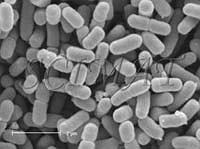 |
| Bar: 2 µm |
|
Although commonly regarded as waterborne, shigellosis is also a foodborne disease - restricted primarily to higher primates, including humans. In the United States, Shigella species cause approximately 450,000 cases of gastroenteritis each year. Infections occur predominately among young children and usually are associated with poor hygienic conditions in child-care settings. However, an outbreak of multi-resistant Shigella sonnei in Australia was reported from a long-stay geriatric nursing centre. In 2002, over 200 people were infected in eastern Ontario (Canada). The source of infection was traced to a contaminated Greek salad. In the United Kingdom, a Shigella sonnei outbreak was associated with the consumption of Iceberg lettuce. There are four Shigella species: S. flexneri, S. boydii, S. sonnei, and S. dysenteriae. The SEM image above shows S. sonnei. All species cause bacillary dysentery or shigellosis (bloody feces associated with intestinal pain). A case paper on Shigella sonnei enterocolitis and rhabdomyolysis is available here. | |
|
A Shigella sonnei culture on a desoxycholate citrate agar plate was kindly provided by Dr. Burton Blais and Mr. Dev Nundy. Several well developed colonies were transferred, along with the underlying agar gel into a cacodylate buffered (pH 6.8) 2% glutaraldehyde solution. The colonies separated from the agar gel during subsequent dehydration in a graded ethanol series. They were critical-point dried and sputter-coated with gold for scanning electron microscopy. The micrograph shows a top view of a colony.
Updated: May 24, 2007 ©SCIMAT 2007 |
|